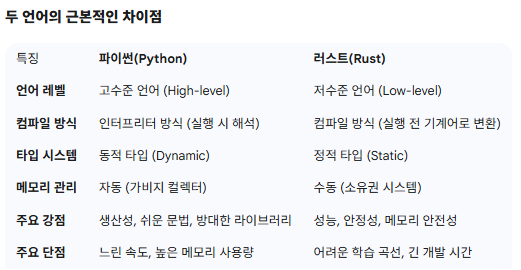[Just Do Rust - 러스트 기초부터 고급까지](https://wikidocs.net/book/16747)
위키독스
온라인 책을 제작 공유하는 플랫폼 서비스
wikidocs.net
C언어를 처음 접한 것이 1990년입니다. 이후, C++/C#, Java, VBA, Python 등의 언어를 사용했고, 요즘 관심있는 언어가 Rust입니다.
관심 가지는 이유는 C언어의 성능과 Java나 Python 같은 안정성과 편리성을 가지고 있기 때문입니다. 특히, NSA(미국 국가안보국)에서 메모리 안전 문제로 C나 C++ 대신에 Rust와 같은 안전한 언어를 사용하도록 권고 했기에, 미국을 중심으로 기존의 C/C++로 된 코드를 Rust로 바꾸는 작업이 이루어지고 있고, 안전성이 요구되는 프로그램은 Rust로 개발되는 추세여서, 앞으로 Rust 언어의 활용이 많아질 것으로 보이기 때문입니다.
NSA가 권고하는 메모리 안전한 언어Python, Java, C#, Go, Delphi/Object Pascal, Swift, Ruby, Rust, Ada
성능까지 고려하면 Rust가 거의 유일한 C/C++ 대체 언어
필자가 생각하는 향후 Rust가 각광 받을 분야는,
- 웹서버: 안전성과 성능이 좋아서, 현재 Java로 되어 있는 웹서버쪽은 Rust로 많이 전환될 것으로 예상
- 암호 라이브러리: C/C++로 되어 있는 암호 라이브러리는 항상 Buffer overflow의 위험을 내재하고 있습니다. 이 부분도 Rust로의 전환이 예상됩니다.
- 소형 기기 펌웨어: 구글은 이미 Android Virtualization Framework를 Rust로 포팅함. 대부분 C/C++로 작성되어 있어 메모리 안전성이 문제되는 펌웨어 단 모듈들은 Rust로 바꿔질 것임
성능도 좋고 안전하기도 한, 두 마리 토끼를 다 잡은 대신에, Rust 언어를 배우기는 쉽지 않습니다. 안전한 메모리 처리를 위해서 Rust에서 컴파일 전에 체크하는 '소유권', '에러처리', '타입 체크' 등을 개발자가 알아서 코드에 반영해야하기 때문입니다. 그렇지 않으면 아예 컴파일이 되지 않습니다. Java나 파이썬을 배우는 것 대비 2~3배 정도는 시간을 더 들여야 Rust에 익숙해질 것입니다.
이 책은 한국에 있는 개발자를 대상으로 Rust 언어를 보다 쉽게 익숙하게 익힐 수 있도록 제작되었습니다.
효율적으로 공부할 수 있도록, 실제 꼭 알아야하는 부분만을 추릴려고 노력했습니다. 따라서, 이 책에서는 Rust에서 제공하는 모든 내용을 담지는 않습니다. 메뉴얼이 아닙니다.
그러나, 꼭 필요한 부분은 가능한 자세하고 깊게 설명합니다.
챕터 내용을 익히는데 좀 더 도움이 되도록 챕터 내용을 그대로 따라 해볼 수 있는 유튜브 영상 링크입니다.
'프로그래밍 > Python' 카테고리의 다른 글
| [python] Blackhole Glow using python (0) | 2025.09.04 |
|---|---|
| [python] ./input/ 폴더 안에 있는 엑셀파일을 찾아서 데이터 있는 셀의 앞뒤 공백을 삭제 (1) | 2025.08.28 |
| [python] python, rust 의 관계 (1) | 2025.08.25 |
| [python] pyx - The next step inPython packaging (2) | 2025.08.18 |
| Rust, Python, TypeScript: 새로운 프로그래밍 3대장(Trifecta) (1) | 2025.08.11 |






